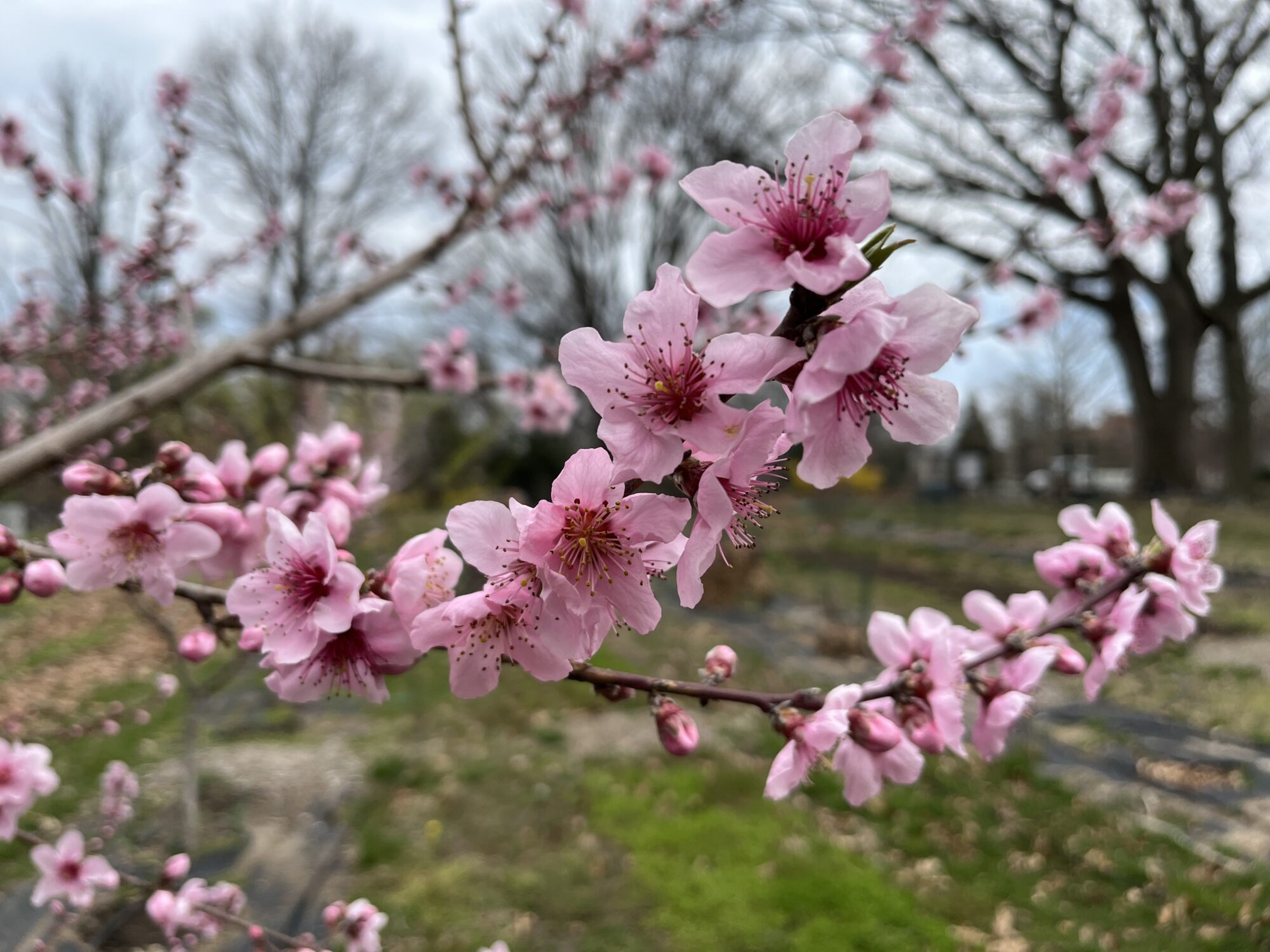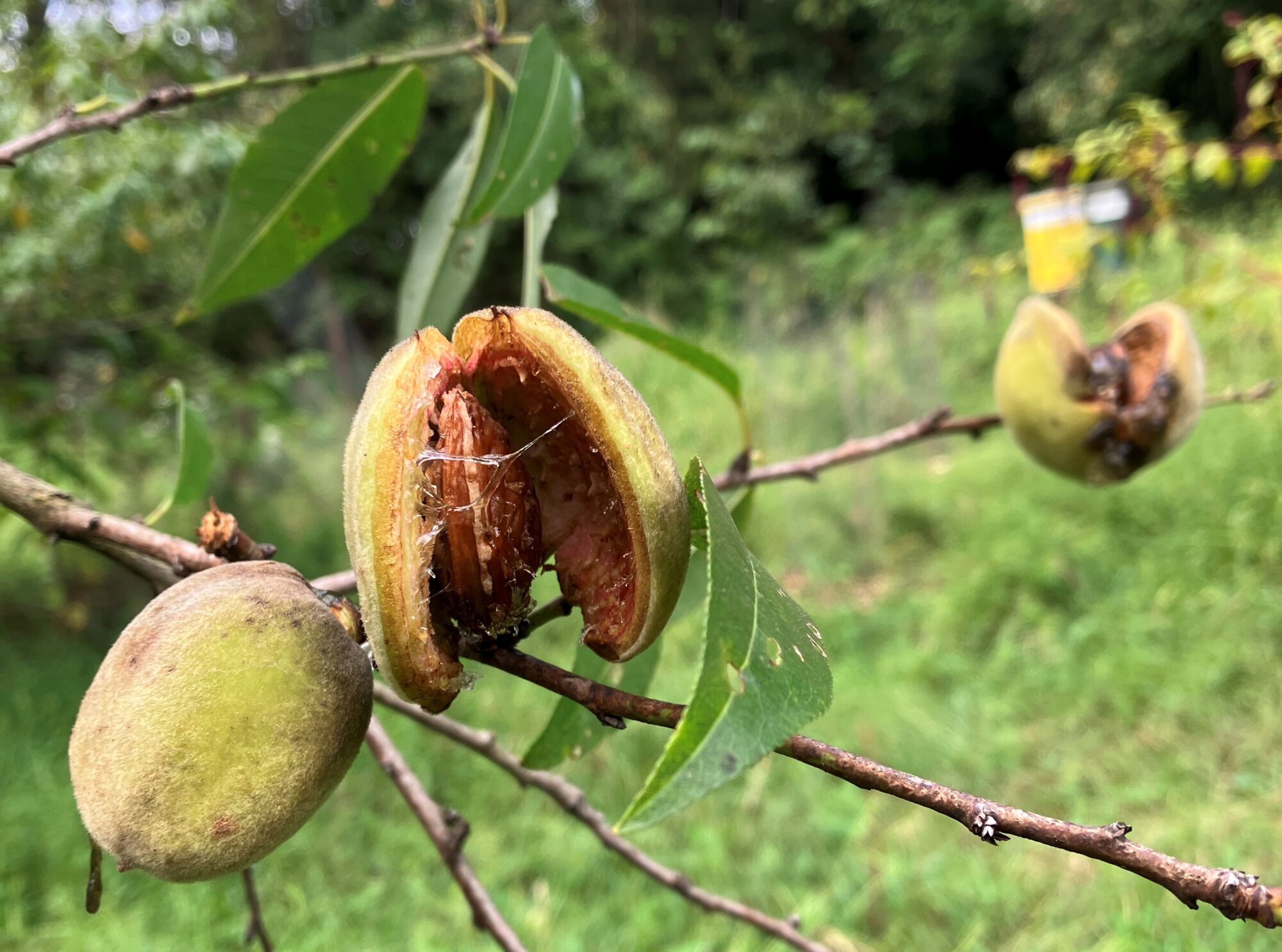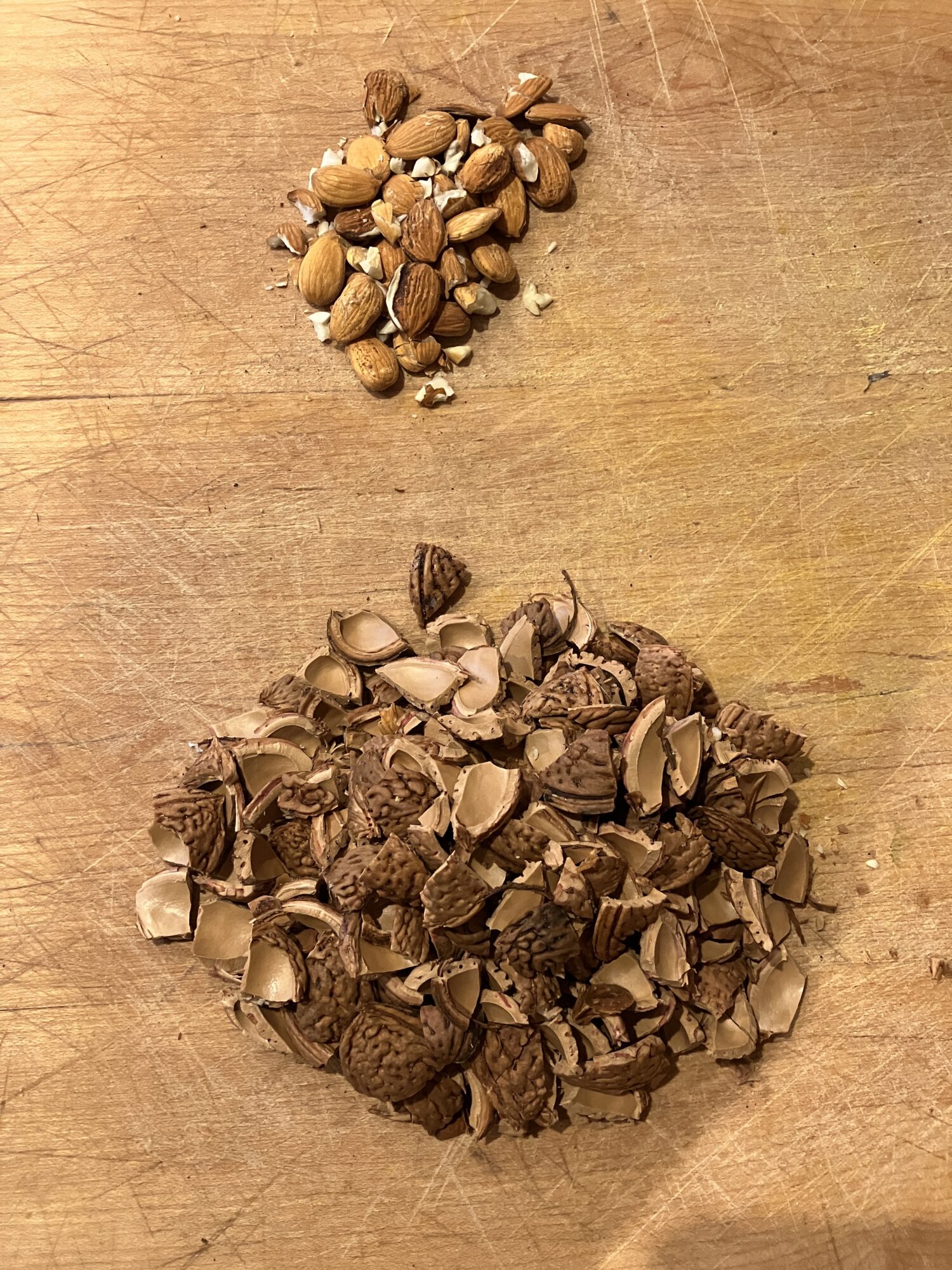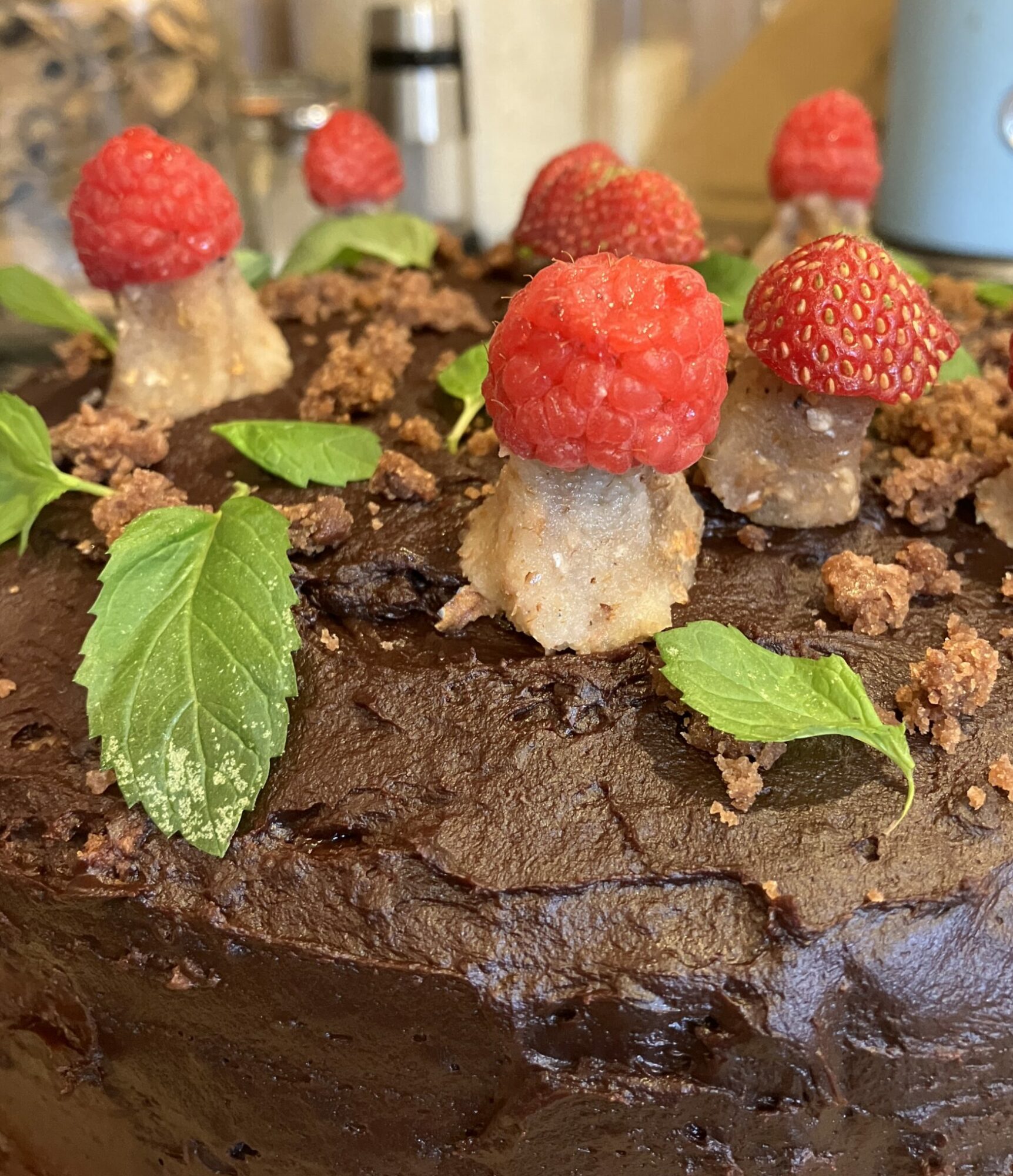
It may surprise you, but we can grow almonds in Philadelphia. Hardy almonds that is, which are not actually true almonds, but a peach-almond cross. The almonds we generally come across in the US are California-grown. They have a bad rap for drinking too much water out there and demanding a constant haze of herbicides. But hybrid hardy almonds were developed for their cold tolerance and late blooming qualities by Washington State University to extend where almonds can be grown. The most common cultivars are ‘Hall’s Hardy’ and ‘Reliable’.
The hardy almond is a self-pollinating tree which grows 15-20 feet and can be planted in USDA zones 5-9. It requires full sun, well-drained soil, and is a good example of an edimental—both edible and ornamental. Hardy almond has gorgeous pink blossoms in the spring and fuzzy green fruits that appear much like peaches. The fruits (technically drupes) split open like leathery clam shells at the end of summer revealing a sandy-colored pit within. This pit houses the kernel we eat. The whole fruit can be shaken from the tree, drupes removed and composted, and the kernels dried for storage or eaten fresh.
This year was my first harvest. I planted two trees in the fall of 2020. Three years in, I’m getting about 40 almonds from each tree. Not what you’d call a motherload, but at maturity my trees will supposedly yield 10-20lbs of nuts. Some people just grow Hall’s for its ornamental, show-stopping blossom display, and don’t bother harvesting the nuts which are slightly more pungent and bitter than your store bought variety. This year, however, my daughter wanted to make some mushrooms out of marzipan—so I bothered.

Harvest
Please see our disclaimer at the end of the article before consuming this or any other unfamiliar plants.
Harvesting was easy (unlike peaches). We simply put down a tarp and shook the tree. No holding the ladder. No crying when branches snapped off in our hands. The nuts were easily removed from their drupes. We set them aside to dry for a few weeks. When we could hear the kernel shaking inside the shell we knew they were ready to crack. We wrapped them in a towel on a cutting board and smashed them with the bottom side of a marble mortar. Most of the nuts came out whole and clean.
Hardy almonds can also be harvested in the spring, as ‘green almonds’ that are eaten whole with their casing before the shell becomes hard.

Toxicity
I was leading a tour of my food forest this summer and had one of those record-scratching moments when an attendee raised their hand and asked why I was growing my hardy almonds next to peach trees. “Aren’t you afraid of toxicity?” he asked. This is the last thing you want to hear when your trees have already been in the ground for a few years, and you have not only been eating the nuts, but feeding them to your children.
If you buy a hardy almond from One Green World, you will see a warning that reads— “Since this variety is a peach and almond hybrid, it is highly recommended to boil almonds to remove any toxins prior to consuming.” My own nursery made no such disclaimer. What’s this all about?
First I should explain that there are different kinds of almonds. They are usually referred to as sweet almonds (mostly grown in California) and bitter almonds (mostly grown in Europe and North Africa). These almonds likely diverged from a single bitter wild stock that developed a genetic mutation thousands of years ago. This fortunate mutation rendered the inedible wild fruit less toxic, and humans started cultivating a new variety of sweet almonds. Bitter almonds have 40 times more cyanide than the trace levels found in sweet almonds. It turns out 5-10 raw bitter almonds can kill a small child, which is why they can’t legally be sold in grocery stores in the US. Also they are so bitter that most people can’t tolerate eating them. Bitter almonds are grown for making almond extract and almond flavored liqueurs. (Side note! Inside each bitter almond, the amygdalin is separated from the enzymes it needs to react. It only becomes activated and poisonous when chewed on by unwitting herbivores and humans who crush the separated compartments together. It’s like an organic explosive devise, and is the tree’s way of defending its progeny. Just one of nature’s little murderous miracles.)
Other stone fruits like apricots, cherries, plums, and peaches also contain amygdalin in their pits—so do the seeds of pome fruits like apples and pears. We don’t eat the pits or seeds of these fruits, so their toxicity doesn’t effect us, but when a peach tree is allowed to cross-pollinate with a hardy almond, the bitter gene of the peach kernel can up the amount of amygdalin in the hardy almond.
When in doubt about the cyanide in your almonds, just cook them. Hydrogen cyanide is reduced in almonds through baking (by 79.4%) microwaving (by 87.2%), and water boiling (by 98.3%)—transforming them from toxic to tasty. Small amounts of cyanide have even been shown to improve digestion and benefit the treatment of cancer. You know what they say—the bitter is the medicine. But not too much!
I was slightly worried about the toxicity of our almonds, due to the proximity of my peach trees, so I blanched our nuts and blended them with sugar to make some birthday cake marzipan mushrooms. It took exactly the amount of almonds we had, and I was able to feed one mushroom to each of the children at the party without worrying even slightly about killing them.

This blog post was contributed by POP Lead Orchard Volunteer Anisa George.
Sources
1. How Almonds Went from Deadly to Delicious
3. Adventures with Almonds, Part I: The Marvelously Fragrant Hall’s Hardy Almond
4. How Poison Fruit Pits Became Irresistible to Humans
5. Reduction of cyanide content of bitter almond and its oil using different treatments
6. Plants for a future: Hardy Almond
7. Apricot Kernel “Bitter Almonds” pg 179
8. What are Green Almonds and When Are They in Season?
SUPPORT US! If you found this entry useful, informative, or inspiring, please consider a donation of any size to help POP in planting and supporting community orchards in Philadelphia: phillyorchards.org/donate.
DISCLAIMER
The Philadelphia Orchard Project stresses that you should not consume parts of any wild edible plants, herbs, weeds, trees, or bushes until you have verified with your health professional that they are safe for you. As with any new foods that you wish to try, it is best to introduce them slowly into your diet in small amounts.
The information presented on this website is for informational, reference, and educational purposes only and should not be interpreted as a substitute for diagnosis and treatment by a health care professional. Always consult a health care professional or medical doctor when suffering from any health ailment, disease, illness, or injury, or before attempting any traditional or folk remedies. Keep all plants away from children. As with any natural product, they can be toxic if misused.
To the best of our knowledge, the information contained herein is accurate and we have endeavored to provide sources for any borrowed material. Any testimonials on this web site are based on individual results and do not constitute a warranty of safety or guarantee that you will achieve the same results.
Neither the Philadelphia Orchard Project nor its employees, volunteers, or website contributors may be held liable or responsible for any allergy, illness, or injurious effect that any person or animal may suffer as a result of reliance on the information contained on this website nor as a result of the ingestion or use of any of the plants mentioned herein.